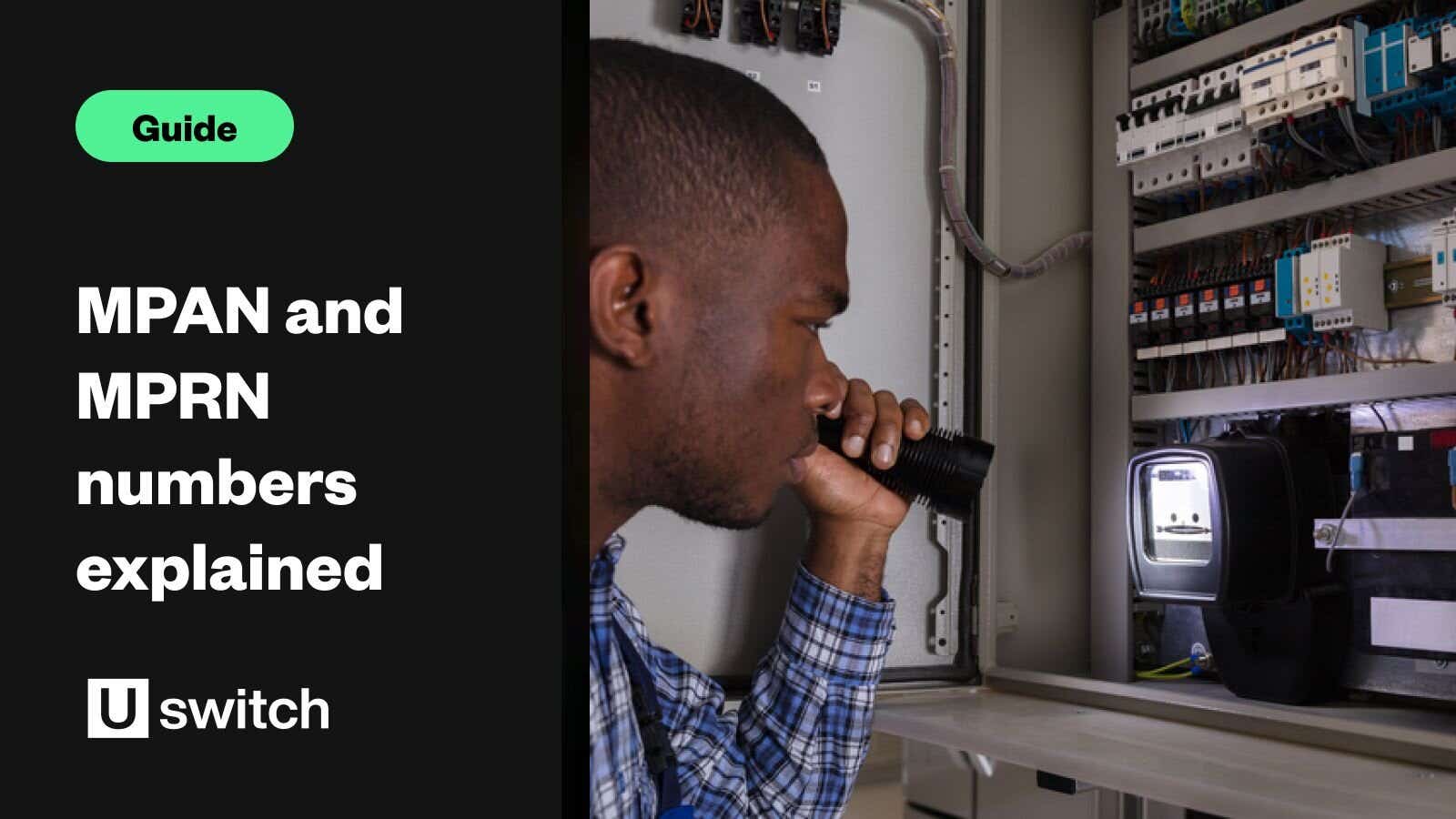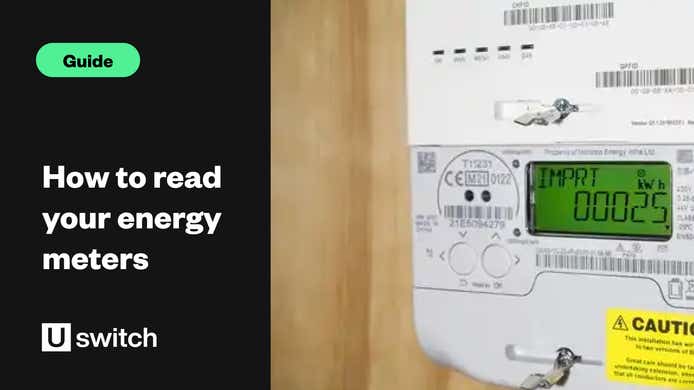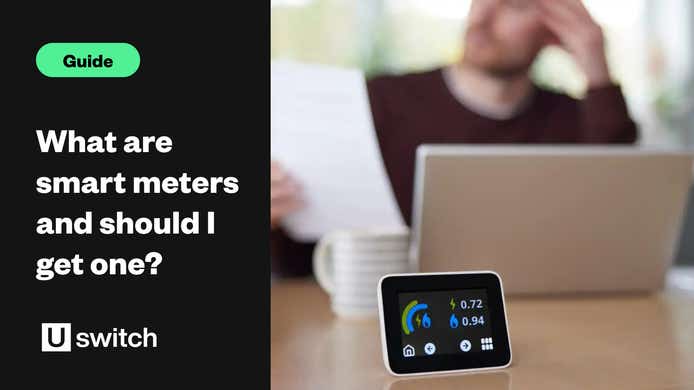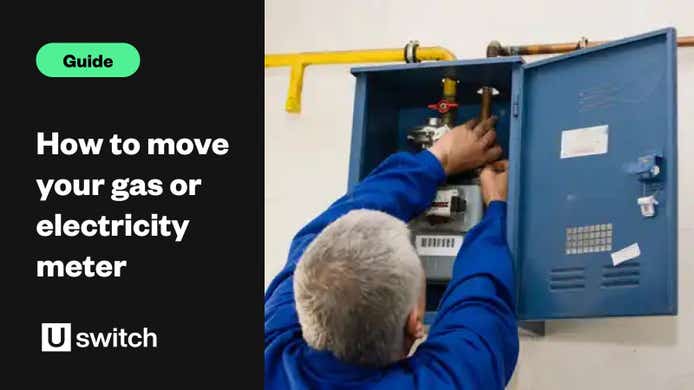Unlike your account number, which identifies you as a person, both MPAN and MPRN numbers are permanently tied to your property. Therefore, they stay the same when you switch tariff or supplier. They also don’t move home when you do, which means you need to know these numbers when you move home or switch energy suppliers.
Read on to find out more about your home’s MPAN and MPRN numbers, what makes them different from your gas and electricity meters’ serial numbers, and – most importantly – where you can find them when you need to.
What is an MPAN number?
MPAN stands for Meter Point Administration Number. It’s a unique 21-digit number that is preceded by an ‘S’ and which identifies your home’s electricity supply.
What is an MPAN number used for?
The MPAN number is used primarily to uniquely identify your property’s electricity supply, but it also contains information about your tariff type (single- or multi-rate), location and network operator.
It’s also used to help your supplier calculate part of your electricity bill. That’s because the Line Loss Factor Class (LLFC) portion of the MPAN number determines how much needs to be paid to your supplier to cover the costs of delivering electricity to your home. Find out more with our gas and electricity utility bills breakdown.
The MPAN is also important because it’s tied to your property, which means it’s used to confirm your address when switching electricity supplier or moving home.
You can use the online MPAN Checker to confirm your Profile Class, Meter Time-Switch Code, Distributor and Unique Identifier. Simply input your MPAN number into the boxes and click Check. If it comes back invalid, check all the numbers and remember that the Profile Class should be two digits (some energy bills drop the leading 0 when displaying the MPAN number).
Understanding the MPAN structure
The MPAN is often displayed on electricity bills in a grid-like fashion over two rows, like so:

The top row displays the first part and is broken into three segments:
- 00: a two-digit number that identifies the meter’s Profile Class. Most domestic MPANs are either 01 (Domestic unrestricted) or 02 (Domestic dual-tariff meter)
- 111: the middle segment displays the Meter Time Switch Code (MTC), which tells suppliers whether the supply is single-rate, day/night (Economy 7 or 10), or seasonal time of day
- 222: this displays the Line Loss Factor Class (LLFC), which is used by the supplier to help calculate distribution charges. This is the portion of your bill that pays the transmission charges for the delivery of electricity to your home.
The final row displays the main 13-digit Unique Identifier number – either as a single number or broken into multiple segments. This is the key part of the MPAN used to identify the property’s electricity supply. It contains three elements:
13 – the first two-digit number is the Distributor ID. This identifies which distribution area you’re in as well as your network operator. If you’ve just moved into a property and you have access to your MPAN number, you can use this in conjunction with the links below to identify its current electricity supplier through your network operator’s online search tool or email query form:
| ID | Region | Operator |
|---|---|---|
| 10 | East of England | UK Power Networks |
| 11 | East Midlands | National Grid |
| 12 | London | UK Power Networks |
| 13 | Merseyside & Northern Wales | SP Energy Networks |
| 14 | West Midlands | National Grid |
| 15 | North Eastern England | Northern Powergrid |
| 16 | North Western England | Electricity North West |
| 17 | Northern Scotland | Scottish & Southern Electricity Networks |
| 18 | Southern Scotland | SP Energy Networks |
| 19 | South Eastern England | UK Power Networks |
| 20 | Southern England | National Grid |
| 21 | South Western England | National Grid |
| 23 | Yorkshire | Northern Powergrid |
- 1234 5678 – this is the main part of the MPAN number and is its Meter Point ID Number. It’s a unique number within your distribution area, and allows your supplier to pinpoint your home’s exact electricity supply.
- 345 – the final three digits are known as the Check Digit. This is calculated from the Distributor ID and Meter Point ID to ensure both numbers are correct.
Where to find your MPAN number on your electricity bill
Your full MPAN number is a 21-digit number beginning with S, and the easiest place to find this is on any electricity bill for your current property.
It’s often printed in two rows with something like S – 00 – 000 – 0 across the top and a 12- or 13-digit number in the format 00-0000 0000-000 across the bottom, which is often referred to as the ‘Supply number’. The bottom number is what you need. Find out what each part of the MPAN number can tell you about your home’s electric supply below.
Where to find your MPAN number on your electricity meter
Your MPAN number isn’t printed or displayed on the meter itself, but you can get it from your smart meter’s In-Home Display. Tap the OK button to bring up the list of menus, then tap right until Meter Information is displayed. Tap OK and right again to display the 13-digit Meter Point ID Number you need to give to a new electricity supplier (or your current supplier if you’ve moved into a new home).
What is an MPRN number?
MPRN stands for ‘Meter Point Reference Number’ and is used by energy suppliers to identify the gas supply at your property. You’ll usually find it on your bill next to ‘Meter Point Reference’, and its usually a number between six and 10 digits in length. Sometimes it may be preceded by the letter ‘M’, so M1234567890 or M-9876543210, for example.
As with your home’s MPAN number, the MPRN number allows your supplier to correctly identify your home’s gas supply point to ensure you’re being charged for the correct supply. Again, you’ll need to know a property’s MPRN number when moving in or when switching gas supplier.
NOTE: Northern Ireland uses a different system to identify gas and electricity supplies – here, MPRN numbers are used to identify your electricity supply.
Where to find your MPRN on your gas bill
As with the MPAN number, your MPRN number should be clearly indicated on any gas bill for your property, often in the ‘Charges in Detail’ section. It’s often referred to as ‘Meter Point Reference’ and is a number that’s 6-10 digits long.
Where to find your MPRN number on your gas meter
In some circumstances, you may be able to find your MPRN number recorded on your gas meter. If it’s not there and you have a smart meter, you may be able to get it from your meter’s In-Home Display. Navigate to the Meter Information section, then tap the gas/electric button once to show your gas meter reading followed by its MPRN number.
If you can’t find your MPRN number and don’t have a bill to hand, you can also get the MPRN number using the Find My Supplier website.
Simply enter your postcode, read and accept the terms and conditions, and click ‘Find Address’. Click the address list and select your house or flat number or name from the dropdown menu that appears. After confirming the address is correct, you’ll be shown your property’s MPRN (Meter Point Reference Number), gas supplier and gas transporter.
What is a meter serial number?
Meter serial numbers are assigned to your individual gas and electricity meters. They confirm those specific meters are recording your energy usage, which helps verify you’re being billed correctly for the gas and electricity you use. Meter serial numbers are sometimes referred to as MSNs or meter IDs.
The key difference between your meter serial numbers and MPAN or MPRN numbers is that they’re not tied to your address; instead, each MSN is linked directly to its meter. This means that if you change your meter for any reason – for example, when upgrading to a smart meter – then the meter’s serial number will change too.
Where can you find the electricity meter serial number?
You can find your electric meter’s S/N (serial number) on your bill. It’s usually displayed in the detailed charges section under ‘Energy charges for meter’ followed by the serial number.
You should also find your electric meter’s S/N is displayed on the meter itself alongside a barcode (unfortunately, some meters have more than one barcode, so bear this in mind). There’s no single standard for meter serial numbers, so look for the following clues:
- The barcode is accompanied with a tell-tale ‘S/N’ followed by the serial number
- On older standard meters, the MSN is between nine and 12 digits long and often starts with the letter F
- On newer smart meters, look for a serial number that begins with 14P or 15P
It’s worth checking the S/N recorded on your bill against the serial number on your meter to verify the correct meter is being recorded. If the numbers don’t match, contact your electric supplier to report the discrepancy and make sure you’re being billed correctly. You could find yourself being charged for someone else’s electricity.
Where can you find the gas meter serial number?
As with electric meters, the location of your gas meter’s MSN can be found both on your bill and the meter itself. look for it on your bill where it should again be displayed in the detailed charges section under the same ‘Energy charges for meter’ heading.
If examining the meter itself, look for the following:
- Gas meter serial numbers are a combination of letters and numbers
- On older gas meters without a barcode, the meter ID may be printed in red on the front of the meter. It’s usually longer than your electricity meter’s MSN, and often begins with ‘L’ and ends ‘M’
- Smart meters print the serial number immediately above or below the meter’s barcode – one model (Flonidan SciFlo) actually displays two barcodes. In this instance, the MSN is the shorter 14-digit number at the top
Again, it’s a good idea to check the meter serial number recorded on your bill against the one on your meter, to make sure you’re not inadvertently being billed for someone else’s gas usage. If you find they don’t match, contact your gas supplier.
How do you read your meter?
If you have a smart meter, then you should no longer need to take regular meter readings; instead, meter readings are sent automatically on a regular basis to your supplier. However, you can still track your electricity usage in real time from your smart meter’s In-Home Display (IHD). You can also use the IHD to track your energy costs over the course of a day, week or longer.
You can also read your meters directly from your IHD – either to satisfy your own curiosity or to resume sending meter readings if your smart meter becomes ‘dumb’ for any reason (usually because you’ve switched energy supplier, and the smart meter is an older SMETS1 model). In this case, look for a meter reading option on the main menu or go hunting through the main menu for a Meter Information section. Tap OK to view your electricity meter’s current reading or tap the electricity/gas button to display your gas meter reading.
Find out more about your smart meter with our comprehensive guide.
How to read your non-smart meter
If you’ve not yet upgraded to a smart meter, you should take regular meter readings – once a month or every quarter – to ensure your energy bills remain accurate. Relying on estimated readings over a long period could result in a hefty surcharge if you use significantly more energy than your supplier’s estimate.
Both your gas and electricity meters display energy consumption using kilowatts per hour (kWh). You’ll need to provide this reading on a regular basis from both meters to your energy supplier.
There are different types of non-smart meter depending on their age, ranging from modern digital meters with LCD screens to old standard meters that display the numbers from left to right using old mechanical wheels. Finally, dial meters display each number as a dial not unlike a clock face. The table explains how to read each type depending on whether it’s gas or electric:
| Meter type | How to read (electric meter) | How to read (gas meter) |
|---|---|---|
| Digital meter | Record the first five numbers; ignore any numbers after the decimal point | Write down the first five numbers (left to right) and ignore the rest after the decimal point |
| Standard or imperial | Record the five black numbers from left to right. Ignore any red numbers (or numbers after a decimal point) | Record the four black numbers from left to right and ignore the rest. |
| Dial meter | Read the first five dials from left to right – if any are between two numbers (say 4 and 5), record the lower number (4). Ignore any red dials or dials marked 1/10. | Read the first four dials only – again, record lower numbers when the dial is between them (so 3 when it’s between 3 and 4). Ignore all other dials |
If you have a dual-tariff meter like an Economy 7 electricity meter, you’ll need to write down two numbers. They should be clearly marked as low or night (off-peak) and normal or day (peak) – make sure you record them correctly.
Once you have your meter reading, check with your supplier how it should be submitted. Options include:
- Via your energy supplier’s website or mobile app
- Call your supplier – check its website for the correct phone number to use.
Find out more with our guide on how to take an energy meter reading.
FAQs
Is an MPAN or MPRN the same as a meter serial number?
No, the MPAN and MPRN numbers are used to identify your home’s electric and gas supplies. The meter serial numbers (also known as meter IDs or MSNs) identify the actual meters. Your MPAN and MPRN numbers are tied to your property’s actual electricity and gas supplies, so never change. In contrast, the meter serial numbers are used to identify the actual meter. This means that if you upgrade to a smart meter or replace one or both of your meters for any reason, their MSNs will change.
Will my MPAN and MPRN change if I switch energy supplier?
No, your MPAN and MPRN are fixed to your property, so don’t change when you switch supplier. Neither can you take these numbers with you when you move home; instead, you’ll need to find out your new property’s MPAN and MPRN numbers using the techniques described above.
Can I find my MPAN without an electricity bill?
Yes, but you may need to contact your energy supplier to get this information. If you’ve just moved to a new home, speak to the property’s current energy supplier, its previous resident or – if you’re renting the home – your landlord. You can usually also find the MPAN number on your smart meter’s In-Home Display.
How do MPRN numbers work in Northern Ireland?
Northern Ireland uses a different system to identify gas and electricity supplies to the rest of the UK. This follows the Irish system, which means MPRN is an 11-digit number used to identify your electricity supply. Visit ESB Networks for help locating your MPRN number.
Your gas supply is identified by its Gas Point Reference Number (GPRN). If you can’t get this from a bill or the property’s previous owner (or your landlord), call Gas Networks Ireland on 1800 464 464 (8am-8pm Monday to Friday, 9am-5.30pm, Saturday).
How do I find my energy meter number?
You’ll find your MPAN and MPRN numbers in various places. They include:
- Any energy bill for the property: This includes gas and electricity bills left behind by your home’s former residents
- Your property’s current supplier: If you’ve moved home and the previous occupants left details of who currently supplies energy to the property, you can contact the supplier to get the information you need
- Your new landlord: If you’ve moved into a rental property, your landlord should be able to provide you with its MPAN and MPRN numbers
- Your smart meter (both MPAN and MPRN numbers)
- Your gas meter (MPRN only)
- Use an online service: you can use a single website to locate your MPRN number or contact your property’s electricity network operator to help track down your MPAN number.




